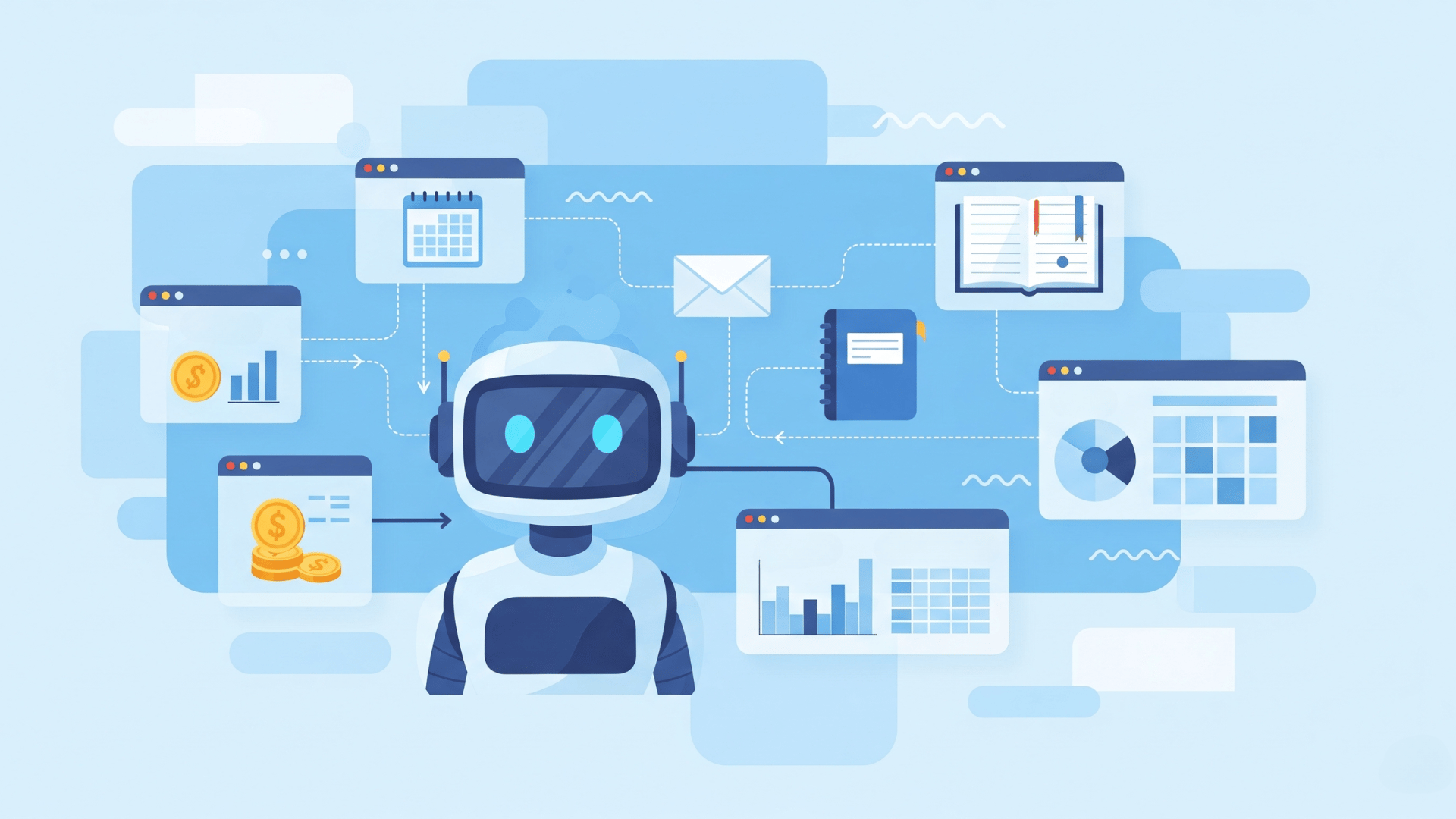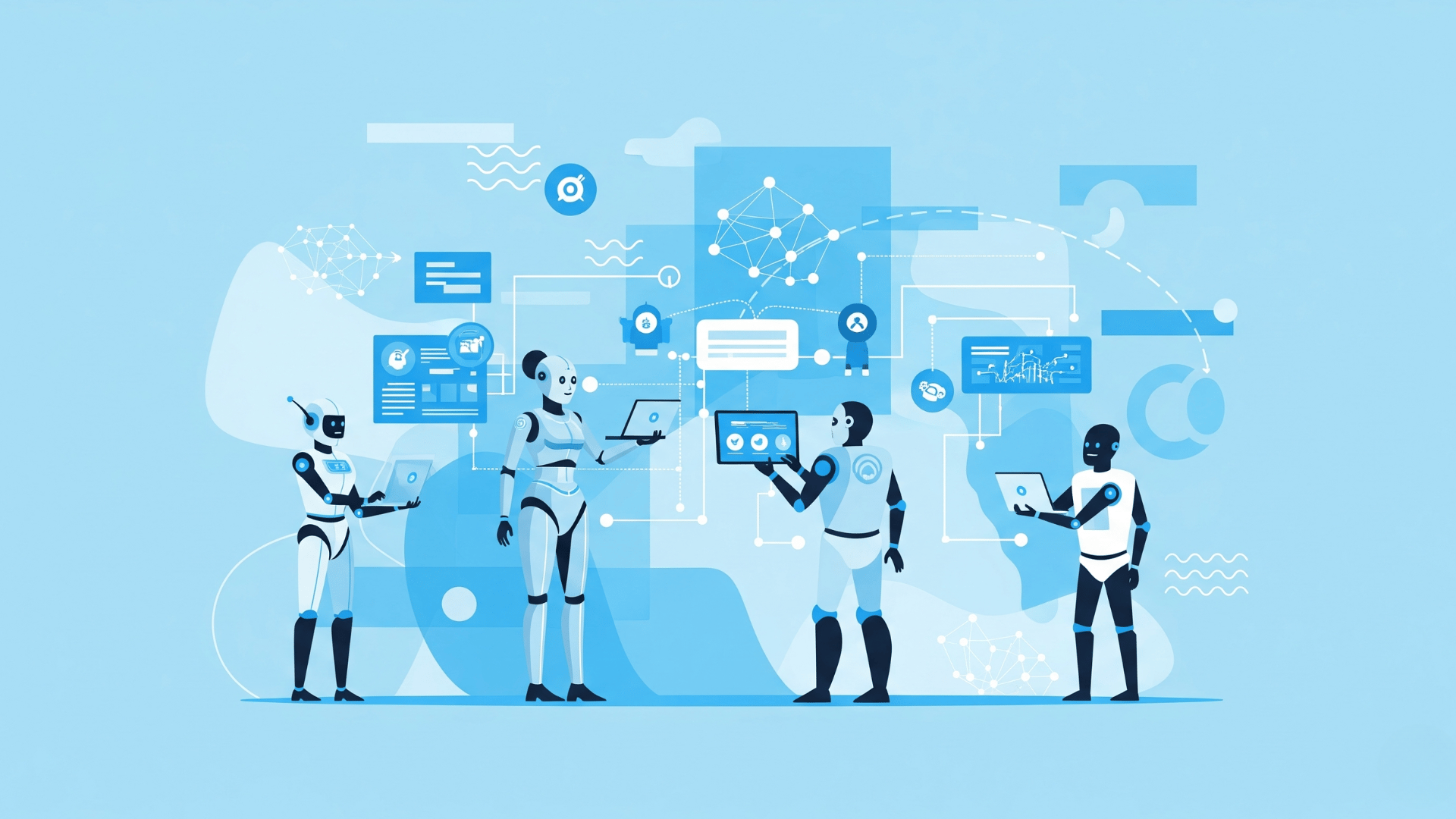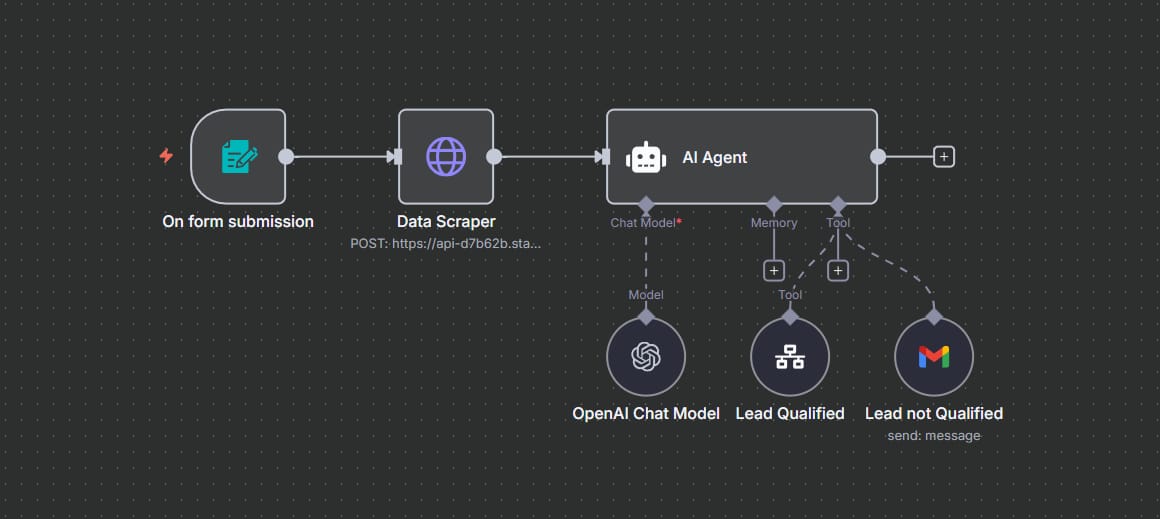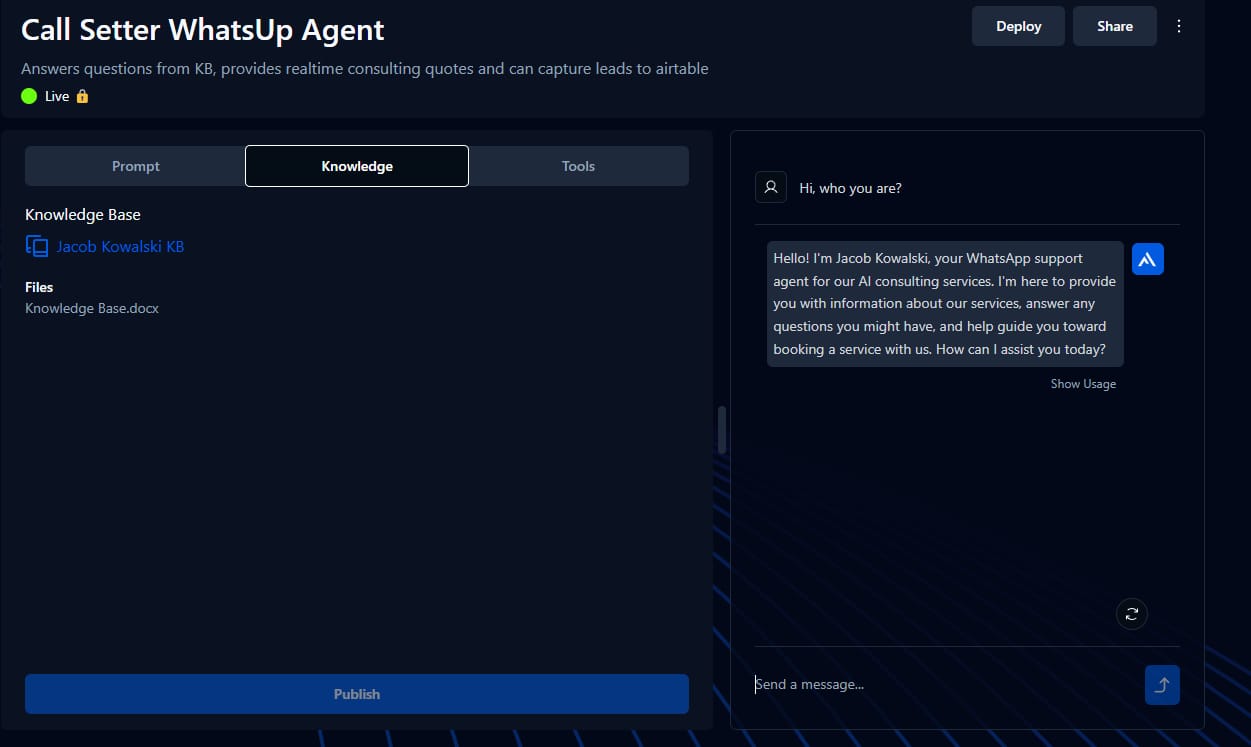- Jacob Kowalski
- Posts
- AI Agents Explained - 3 practical builds
AI Agents Explained - 3 practical builds
AI Agents are taking the AI space by storm! Learn more about what is AI Agent and what you could use it for!

Who am I?
Hello and welcome to my next article in the AI Knowledge Hub! 🙋♂️
My name is Jacob Kowalski - a corporate tax consultant from Poland who is really into AI stuff.
I am creating many really cool things with AI: chatbots, AI assistants, automations, agents, etc. 🤖
I think we are living in a the biggest revolution of our generation and want to share my thoughts about it. Maybe for some of you it will be interesting or maybe you want to share your take on this too.
If you want to know more about me and what I am doing, check out my page with the button below. 👇
Forget about AI chatbots, its AI Agents time!
Hi everyone! 👋
AI space is evolving so fast, that every month or week we get something new on the table. 🆕
First it was basic LLM-based AI chatbots 💬
Next, these LLMs were getting so much smarter, providing the real business value 🧠
A little bit later we’ve got AI images&video generators. 🖼️
Getting closer to present we can try coding assistants. 💻
Right now, we have something that connects all the previous tools. Something that will revolutionize the way we work with AI. 🧑💼
Let me introduce the AI Agent! 🤖
Although the Agents are on the top of the AI world debate, for non-AI-nerds it can still be a mystery. ❌
That’s why in this article I explain in simple terms what an AI Agent is and show my 3 Agents which are both simple to make and provide real value to any business when deployed and prepared correctly. ✅
Let’s get into it! 👇
What Exactly Is an AI Agent? (And Why Everyone's Talking About Them)

Imagine this 💭:
You walk into your office on Monday morning, and before you've even finished your coffee, your digital assistant has already processed 50 invoices, updated your inventory system, scheduled three client meetings based on everyone's availability, and sent you a summary of the weekend's sales data.
You may think this is kind of BS right now and… in a way it is. This is an example of perfectly prepared, deployed and functioning AI Agent. 🤖
Nevertheless, it gives a general view of what AI Agent is and what it’s doing - let’s break this general description into more understandable pieces. 🤔
AI Agents are autonomous software programs designed to perform specific tasks or make decisions based on data inputs - the difference between Agents and simple AI is: they work independently without you having to babysit them. 👶
Imagine the difference between a calculator and a personal accountant. A calculator waits for you to input numbers and tells you the result. A personal accountant, on the other hand, can access your financial records, analyze your spending patterns, predict cash flow issues, and even make investment recommendations - all without you asking them to do each individual step.
That's exactly how AI agents work compared to traditional AI tools.
The Agents are in the front row in AI discussions right now because they solve real business problems that cost real money.
For business operations, AI agents autonomously complete their cycle, so human employees can do other work.
Instead of having your team manually process invoices, screen resumes, or handle customer inquiries, AI agents can automatically process an invoice, or execute stock market trades, or screen resumes.
Recently I’ve read the KPMG report (here), which show that the majority of organizations are past AI-agent experimentation, 33% of which have achieved the deployment of at least some agents after two consecutive quarters.
This shows that the Agents are the real deal, not next “AI Trend”.
The Difference Between Basic AI vs AI Agents
To ilustrate the difference, please imagine a below scenario :
Your e-commerce business is running a flash sale, and suddenly your website crashes at 2 AM.
With ChatGPT: You wake up, discover the problem, open ChatGPT, explain the situation, ask for troubleshooting steps, implement each suggestion one by one, and finally get the site back up - 3 hours later.
With an (well created) AI Agent: The agent detects the crash immediately, automatically switches traffic to a backup server, sends you a notification about the issue AND the fix, and has your site running again within some minutes - without your action.
That's the difference between reactive and proactive AI.
Not only that, the AI Agents has some more functions that simple AI has not, full breakdown is presented below:
Capability | Simple AI | AI Agent |
|---|---|---|
Autonomy | Responds only when prompted | Works independently, makes decisions |
Memory | Forgets conversation after session | Remembers and learns from all interactions |
Task Execution | Provides information and advice | Actually performs tasks and actions |
Monitoring | No ongoing awareness | Continuously monitors environments |
Integration | Limited to chat interface | Connects with multiple tools and systems |
Tools | Google search, image generation | Vast amounts of tools and automation systems |
Initiative | Waits for user input | Anticipates needs and takes action |
This is not about whether Agents are far better than Simple AI. Both have their use cases.
As Agents are far more complex, they are usually also much more difficult and costly to prepare and maintain. While Chat GPT is a free tool, creating and deploying highly functional AI Agent will be far more time-consuming and capital-intensive.
That’s why Agents are mostly used in businesses where the capital and tech knowledge resources are available.
ChatGPT is an excellent tool for getting information, brainstorming, and solving problems when you're actively engaged.
But AI agents are designed to be your digital workforce - they work without your activity, handle routine tasks automatically, and only involve you when human judgment is truly needed.
The question isn't whether AI agents are better than ChatGPT - it’s about what you expect and how you want to interact with AI.
AI Agent Broken Into Pieces: 3 Essential Components

AI Agent can be compared to highly skilled employee who is working remotely. Just like any great employee, an Agent needs three essential things to do their job effectively:
access to company knowledge,
the ability to think and make decisions, and
the right tools to get work done.
The knowledge base is essentially the agent's long-term memory and information repository. It's where all the relevant data, documents, procedures, and context live that the agent needs to make informed decisions. The classic knowledge base can contain:
Company policies and procedures
Historical data and past interactions
Industry-specific knowledge
Real-time data feeds
Customer information and preferences
Product catalogs and specifications
A customer service agent's knowledge base might contain your entire FAQ database, previous customer interactions, product manuals, and return policies.
When a customer asks about a specific product issue, the agent can instantly access relevant information and provide accurate, consistent responses.
The Large Language Model (like ChatGPT, Gemini, Claude etc.) serves as the agent's brain - the central processing unit that interprets information, reasons through problems, and makes decisions. This is where the actual "intelligence" happens.
By using these models the Agent:
Processes and understands natural language
Analyzes data patterns and trends
Makes logical connections between different pieces of information
Generates responses and action plans
Learns from previous interactions and outcomes
A large language model (LLM) with general-purpose capabilities serves as the main brain, agent module, or coordinator of the system. It's what transforms raw data into actionable insights and decisions.
Tools are what separate AI agents from simple chatbots. While chatbots can only provide information, agents can take real action in the world through their integrated tools.
There is vast amount of different tools, to help you better understand, please check the list below:
Communication tools: Email, Slack, SMS, phone systems
Data tools: Databases, spreadsheets, CRM systems, analytics platforms
Business tools: Calendar systems, project management, invoicing, payment processing
Integration tools: APIs, webhooks, automation platforms
External services: Weather APIs, stock market data, social media platforms
The knowledge base provides context, the LLM brain analyzes the situation and decides what needs to be done, and the tools execute the actual work.
All of these working together is what distinguishes a well-prepared Agent from simple AI tool or system.
How to Create Your First AI Agent
While creating an AI Agent is quite a challenging task, you don't need to be a tech expert or have a massive budget to start.
In fact, some of the most powerful AI agent platforms are designed specifically for regular people who want to automate their daily tasks without writing a single line of code.
The beauty of 2025's AI agent landscape is that these programs are generally no-code tools that help you create both simple and more advanced AI Agents and systems. Let's explore how you can get started today.
The most popular ones (and tested by me) are:
n8n - most hyped and popular right now. The whole platform is the automation/flow builder when you are “connecting dots” or steps to create a whole automated process. n8n has a great agent module, probably the best I’ve seen so far, which can be adjusted to almost any needs. While n8n gives you a lot of tools and potential use cases, it is more challenging platform and requires some previous knowledge or training. Nevertheless the reward is definitely worth it.
Relevance AI - the platform which was previously a tool builder, now implemented the agent module and it is working very well. The good side of Relevance is that you can create your own tools and agents in one platform and connect them seamlessly. Relevance has a lot of powerful apps to connect in order to create the tools, so I highly recommend trying to build something with Relevance.
Voiceflow - the chatbot/voicebot builder platform which enables you to have more control over the conversation between the Agent and the user. As n8n it requires some more technical knowledge, nevertheless the reward is worth the costs.
Make - The Make Agent module is rather similar to the n8n but this one is more simple and beginner friendly. When you are starting with creating Agents I recommend starting with this one, although it won’t give you as many options and the n8n Agent.
Agentive - Agentive is a platform which connects the different parts of the Agents (Knowledge, Brain and Tools) and help you deploy your Agent across many different platforms like WhatsApp, Instagram, Webpage etc. Agentive is a very beginner-friendly and low-cost platform, so when starting it should your first step.
3 Practical Agents
I want to end this article with some practical steps, as creating your own Agents you will learn better and faster than reading about it, so below I am sharing my first three Agents I did, using n8n, Relevance AI and Agentive:
Lead Qualification Agent - n8n

Overview
Firstly I want to paint a big picture of what this Agent does and what is it for.
Many businesses have their contact forms on their webpage, through which you can contact them to arrange a call or discuss their offer.
As the business is growing, the number of clients is increasing as well to the point when checking whether the clients (leads) are a good fit or not - sometimes they have a low budget, sometimes they are in the different niche or want something we cannot provide etc.
This whole process could take a lot of time, so my idea behind this Agent is that it could qualify the leads automatically based on the given criteria.
Agent Components
This Agent does not need a knowledge base, all criteria and information are included in the prompt given to it.
For Brain, it uses GPT o3 mini which is more complex - in order to understand the lead position and qualify whether it is a good fit or not.
For the Tools, this Agent has some:
Data Scraper - this tool retrieves data from the lead company website and LinkedIn profile and creates a short summary to present the information about the lead.
Lead Qualified Tool - this one is created within n8n and filters the already qualified Lead. For my use case I want to filter if the qualified lead a employee of the company or rather has a personal brand.
Lead not Qualified Tool - as the name says itself, this tool sends an e-mail to the lead with the apologies and explanations that we are not a good fit for the lead needs.
Workflow
Lead submit the form with the information like, company website, linkedin profile link, his business needs, contact e-mail
After submission the Data Scraper tool retrieves information about the company and linkedin profile to create a short summary of the lead.
Based on this information Agent decides whether the lead is qualified or not.
IF NOT: Agent sends an e-mail with apologies and information.
IF YES: Agent uses the Lead Qualified tool to further check if the lead is a company or personal brand.
Based on this filter the Agent sends an e-mail with all the information to appropriate sales team or sales person
Sales Team / Consulting Copilot - Relevance AI

Overview
Main reason for creating this Agent is to help the sales team of consultants better prepare for a sales / consulting call.
The process of researching the client and understanding their position and potential pain points is very time-consuming so this Agent is doing it on your behalf.
Agent Components
This Agent does not need a knowledge base as well, all criteria and information are included in the prompt given to it.
For Brain, it uses GPT 4o mini which is rather simple - as the task mainly includes restructuring the gathered data.
For the Tools, this Agent has only one, the same as in the previous build:
Data Scraper - this tool retrieves data from the lead company website and LinkedIn profile and creates a short summary to present the information about the lead. Also in this case the summary includes good call starters, or strategic talking points to focus on etc.
Workflow
Let’s say we are about to have a call with potential client, we do not have any information about them.
We ask the Agent if it could provide a report for us.
We provide it with the client’s webpage and a linkedin profile.
The Agent gives us a report with all necessary information, so we could start the call fully prepared.
Call Setter Agent - Agentive

Overview
This Agent is slightly different from the previous ones. The main difference is that the Call Setter is the Agent targeting customers, which means it is mainly engaged in the conversation with client not you or your employees.
We all know that speaking with the customers could be a very time-consuming and irritating experience, that’s why this Agent’s goal is to provide all the information to the client and if the client is interested save this information in your database.
Agent Components
As this Agent is providing the customer the information, it has the Knowledge Base which gives it all the information needed.
For Brain, it uses GPT 4o mini which is rather cheap and fast model as we want to deliver quick responses.
The tools are slightly different than the previous Agents:
Cost calculator - this tool enables the Agent calculate the potential cost of the service based on the service and approximate time of delivering. If a client wants to a one-hour consulting call the price is lower than for a ten-hour agent building project.
Saving the client info into database - it does exactly this, grabs the contact data from the customer and saves it into your own internal database.
Workflow
Let’s say that you are providing the cleaning or consulting services.
Someone enters your page and is interested in your services.
They sees that you have a WhatsApp number and sends a message to you with questions: how much for the service and why is it that expensive?
Instead of you, the Agent will respond to the client with the price and further explanations.
If the client is interested, the Agent saves the information in your database like Google Sheets, Excel, Airtable etc.
Summary
Phew… that’s it for this article. 🔚
As you can see Agents are the powerful sector of AI and could be a real threat to especially entry-level employees or those doing repetitive jobs.
That’s why learning how to create them will be a superpower in the future.
I think that in the near future, our interactions with businesses will be 90% handled by Agents or other AI driven software.
But to be fair - the future is not here yet.
I think especially in less-developed countries (like Central and East Europe), for local companies the AI boom hasn't reached them yet.
Of course, this should change, as you can see using these systems is neither that hard nor expensive, the main reason for not adopting these solution is knowledge gap.
That’s why gaining knowledge and skills is the key to better positioning yourself in an AI-driven future, which will eventually come for all of us.
Right now this is really the end.
Thanks for reading.
Jacob.